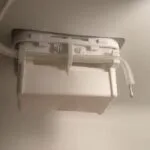Samsung TVs are known for their high-quality displays. But, sometimes problems occur.
If you’re facing issues with your Samsung TV display, you’re not alone. Many users experience screen problems like flickering, lines, or even complete blackouts. These issues can be frustrating and disrupt your viewing experience. Understanding the common causes and solutions can help you fix these problems quickly.
This blog will guide you through the typical display issues and offer practical solutions to get your TV back to perfect working condition. So, if your Samsung TV display is acting up, keep reading to find out how to solve it.

Credit: www.ifixit.com
Common Display Issues
Many Samsung TV owners face display problems that can disrupt their viewing experience. Knowing the common issues helps in troubleshooting and fixing them. Let’s explore some frequent display problems.
Blank Screen
A blank screen is a common issue with Samsung TVs. This problem can be frustrating, but it is often fixable. Here are a few potential causes and solutions:
- Check if the TV is properly plugged in.
- Ensure the input source is correct.
- Try resetting the TV by unplugging it for a few minutes.
- Inspect the HDMI or AV cables for any damage.
- Update the TV’s firmware to the latest version.
If these steps do not work, the issue might be with the TV’s hardware. Contact Samsung support for further assistance.
Flickering Display
A flickering display can be very distracting. This issue can result from several factors. Here are some steps to diagnose and fix a flickering screen:
- Check if the power source is stable.
- Ensure that the cables are securely connected.
- Change the refresh rate in the TV settings.
- Disable any energy-saving features.
- Update the TV’s firmware to the latest version.
Persistent flickering might indicate a deeper issue, such as a failing backlight. Professional repair may be necessary in such cases.

Credit: eu.community.samsung.com
Initial Checks
Experiencing display problems on your Samsung TV can be frustrating. Before diving into complex solutions, start with some initial checks. These steps are simple and can often resolve the issue quickly.
Power Supply
Check the power supply first. Ensure your TV is plugged in securely. Confirm the outlet is working by plugging in another device. Sometimes, a loose connection or faulty outlet can cause display issues.
Cable Connections
Inspect all cable connections. Loose or damaged cables can disrupt the display. Make sure all cables are connected firmly. Look for any visible damage to the cables. Replace any damaged cables immediately.
Check the HDMI connections. Sometimes, a faulty HDMI cable can cause screen problems. Swap the HDMI cable with a new one or try a different port on the TV. This simple step can often fix the display issue.
Screen Calibration
Screen calibration is essential for getting the best picture quality from your Samsung TV. It involves adjusting various settings to enhance the display. By fine-tuning brightness and contrast, you can enjoy a more vivid and sharp picture. This guide will help you adjust these settings easily.
Adjust Brightness
Brightness controls the light level of your TV screen. To adjust brightness, go to the settings menu. Find the picture or display settings. Use the slider to increase or decrease brightness. A well-balanced brightness level ensures better picture clarity. Too high brightness can strain your eyes. Too low brightness makes the picture dark.
Modify Contrast
Contrast affects the difference between the light and dark parts of the picture. Navigate to the contrast option in your display settings. Adjust the slider to see the changes. Increasing contrast makes the whites brighter and blacks darker. This improves the overall image depth. Be careful not to set it too high. High contrast can wash out details. Aim for a balanced setting for a clearer picture.
Software Updates
One common issue with Samsung TVs is display problems. Sometimes, these issues can be resolved by performing software updates. Updating the software ensures your TV runs the latest features and fixes.
Check For Updates
First, check if your Samsung TV has the latest software. Follow these steps to check for updates:
- Press the Menu button on your remote.
- Select Support.
- Choose Software Update.
- Select Update Now.
If an update is available, your TV will download it. Ensure your TV is connected to the internet for this process.
Install Firmware
Sometimes, software updates also include firmware updates. Updating the firmware can fix bugs and improve performance.
Follow these steps to install firmware updates:
- Visit the Samsung Support website on your computer.
- Search for your TV model.
- Download the latest firmware file.
- Extract the file to a USB drive.
- Insert the USB drive into your TV.
- Press the Menu button on your remote.
- Go to Support and select Software Update.
- Choose Update Now and select USB.
Your TV will read the USB drive and install the firmware. Do not turn off the TV during this process.
Following these steps can help resolve many display issues. Keeping your TV updated ensures it runs smoothly and efficiently.
Resetting The Tv
Resetting the TV is often the first step to fix display issues on your Samsung TV. Whether your screen is flickering, showing a blank screen, or has color issues, performing a reset can often resolve these problems. There are two main types of resets: Soft Reset and Factory Reset. Below, we will guide you through both processes.
Soft Reset
A soft reset is the easiest and quickest way to fix minor display issues. This method does not delete your settings or data. It’s like restarting your TV.
- Turn off your TV using the remote.
- Unplug the TV from the wall socket.
- Wait for at least 30 seconds.
- Plug the TV back in and turn it on.
This simple process can clear temporary glitches and restore normal display functions.
Factory Reset
A factory reset is a more comprehensive solution. It returns your TV to its original settings, erasing all personal data. Use this method if a soft reset did not solve your display problem.
Follow these steps to perform a factory reset:
- Press the Home button on your remote.
- Navigate to Settings.
- Select General.
- Choose Reset.
- Enter your PIN (default is 0000).
- Confirm by selecting Yes.
The TV will restart and return to factory settings. This can fix deeper software issues causing display problems.
Whether you choose a soft or factory reset, both methods are effective. Always start with the soft reset and move to the factory reset if needed. Your Samsung TV should be back to normal in no time.
External Device Interference
External device interference can cause display problems on your Samsung TV. Understanding how to troubleshoot these issues can save you time and frustration. Sometimes, the root cause of the display problem is not the TV itself but external devices connected to it. Let’s explore some simple steps to identify and fix these issues.
Disconnect Devices
First, disconnect all external devices from your Samsung TV. This includes gaming consoles, streaming devices, and Blu-ray players. Once disconnected, check if the display issue is resolved. If the problem disappears, it indicates that one of the external devices is causing the interference.
Check Hdmi Ports
Inspect the HDMI ports on your Samsung TV. Damaged or loose HDMI ports can cause display problems. Use a flashlight to check for any visible damage. Next, reconnect the devices one by one. Make sure the HDMI cables are securely plugged in. Check the display after connecting each device to identify the problematic one.
Advanced Troubleshooting
Experiencing issues with your Samsung TV display can be frustrating. Understanding advanced troubleshooting steps can help resolve these problems. Follow these steps to diagnose and fix common display issues.
Test With Another Tv
First, connect the same input source to a different TV. This helps determine if the problem lies with the source or the Samsung TV.
If the display works on another TV, the input source is not the issue. This narrows down the problem to the Samsung TV itself.
Inspect For Damage
Next, examine your Samsung TV for any visible damage. Check the screen, ports, and cables.
Damaged components can cause display problems. Look for cracks on the screen, bent pins, or frayed cables. These signs indicate physical damage.
If you find damage, contact Samsung support for repair options. Professional assistance may be needed to fix the issue.
Credit: www.electro-tech-online.com
When To Seek Professional Help
Samsung TVs are known for their high-quality displays. But even the best technology can have issues. Display problems can be frustrating. Sometimes, it’s hard to decide if you should fix it yourself or seek help. Below are some scenarios when professional help is necessary.
Warranty Check
Check if your TV is still under warranty. This can save you money. Follow these steps:
- Locate your purchase receipt.
- Find the warranty card.
- Read the terms and conditions carefully.
If the problem is covered, contact Samsung. They might fix it for free. Always keep your warranty information in a safe place.
Contact Support
If your TV is not under warranty, contact Samsung Support. They can guide you through troubleshooting steps. Here are some ways to reach them:
- Visit the Samsung Support website.
- Call the customer service hotline.
- Use the Samsung Members app for support.
Provide your TV model number and a detailed description of the issue. This helps them assist you better. Don’t try to fix complex problems yourself. It can cause more harm than good.
Sometimes, reaching out for professional help is the best option. Warranty checks and contacting support can save you time and effort.
Frequently Asked Questions
Why Is My Samsung Tv Screen Flickering?
Your Samsung TV screen might flicker due to loose connections or outdated firmware. Check cables and update software.
How Do I Fix A Dark Samsung Tv Screen?
Adjust the brightness settings or check if Energy Saving mode is on. Sometimes, a factory reset helps.
Why Does My Samsung Tv Have Lines On The Screen?
Lines on the screen may be caused by a damaged display or loose internal cables. Seek professional repair.
What Causes Samsung Tv Screen To Go Black?
A black screen can result from a faulty HDMI cable, a software glitch, or a hardware issue. Try troubleshooting.
How Can I Reset My Samsung Tv Display Settings?
Go to Settings > Support > Self Diagnosis > Reset. This will restore the display settings to default.
Conclusion
Fixing a Samsung TV display problem can be frustrating. Follow these tips to troubleshoot. Check cables and connections. Update your TV’s firmware. Adjust picture settings. If the issue persists, contact Samsung support. They can provide expert help. Always keep your TV in good condition.
Clean it regularly and avoid overheating. A well-maintained TV lasts longer. Enjoy a better viewing experience by addressing display issues promptly. Thanks for reading!




